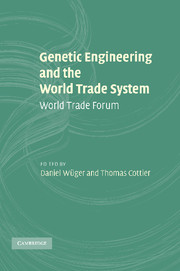Book contents
- Frontmatter
- Contents
- List of contributors
- List of abbreviations
- PART I Introduction and systemic issues
- PART II Intellectual property and gene technology: issues at stake and possible options
- PART III Food security, trade and agricultural production with genetically modified organisms
- PART IV Food safety, international trade and biotechnology
- 10 Trade, environment and biotechnology: on coexistence and coherence
- 11 Risk regulation, precaution and trade
- PART V Medical research, cloning and international trade
- Index
11 - Risk regulation, precaution and trade
Published online by Cambridge University Press: 06 October 2009
- Frontmatter
- Contents
- List of contributors
- List of abbreviations
- PART I Introduction and systemic issues
- PART II Intellectual property and gene technology: issues at stake and possible options
- PART III Food security, trade and agricultural production with genetically modified organisms
- PART IV Food safety, international trade and biotechnology
- 10 Trade, environment and biotechnology: on coexistence and coherence
- 11 Risk regulation, precaution and trade
- PART V Medical research, cloning and international trade
- Index
Summary
Introduction and overview
Risk regulation, precaution and trade have become highly contentious issues in international trade and environment policy. While, for some, ‘precaution’ seems to be a magic word solving all problems and constituting a symbol for effective environmental protection, others see it as a threat to sound science and human development, and as a synonym for protectionism. However, both approaches to precaution often seem to represent a politically motivated misinterpretation of the underlying concept.
But not only is precaution a politically overloaded term, ‘sound science’ is too; this term was coined by the US tobacco industry to discredit studies that concluded that smoking might be harmful to health. Today, the term is increasingly being used to challenge any reasoning that does not deliver the desired result.
The emotions, fears, hopes and irritations involved in the controversy on precaution carry the risk of diverting attention from the underlying issues, and often prevent constructive and solution-oriented ideas from being applied. Interestingly, at national level, most if not all countries apply precaution as a central policy tool. In the international debate, however, precaution has become pivotal in trade and environment disputes and increasingly so in trade and health disputes. The main reason for this might be that the concept of precaution translates different preferences concerning safety into different policies. Thus, it seems that the divergence relates not to precaution as such, but to differences in the perception of risks and differences in preferred levels of protection.
- Type
- Chapter
- Information
- Genetic Engineering and the World Trade SystemWorld Trade Forum, pp. 246 - 284Publisher: Cambridge University PressPrint publication year: 2008
- 1
- Cited by

